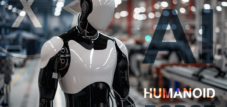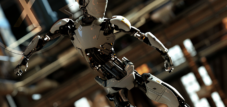Published on: April 19, 2025 / update from: April 19, 2025 - Author: Konrad Wolfenstein

Robot race in China: Humanoid robot at the half marathon in Beijing-Human Against Machine-Image: Xpert.digital
China shows muscles: Humanoid robots run half marathon - a breakthrough?
“Tiangong” runs: China's humanoid robot conquers the half marathon - the details
On April 19, 2025, Beijing wrote technology history: For the first time, Humanoid robots competed against human runners in an official half marathon. The event, which took place in the Yizhuang district of Beijing, brought together over 20 companies and research institutions that sent their two -legged running robots on the 21,0975 km route. The competition revealed both the impressive progress and the existing limits of humanoid robotics: While the fastest person reached the goal after 1 hour 11 minutes, the fastest robot “Tiangong” needed more than twice as long with 2 hours 40 minutes. The event demonstrates China's ambitions, in the global technology race to take artificial intelligence and robotics a leadership position.
Suitable for:
- Sweating robot? Rapid progress in Bionics Robotics with myofiber art muscles and skeletal cooling systems
The competition: structure and participant
The half marathon in Beijing was the first such event to be advertised with robots worldwide and attracted considerable attention. 20 companies and research institutions took part in the event with their humanoid robots, while more than 10,000 human runners had registered for the competition. The running route led through the Yizhuang district of Beijing, with separate areas for robots and people separated by barriers.
Strict rules were considered to participate in the robots: they had to have a humanoid shape and run on two legs. The size specifications limited the participants to machines between 0.5 and 2 meters high with a minimum leg length of 45 centimeters. These guidelines explicitly excluded from participation.
The organizers allowed both autonomously acting and remote -controlled robots, which reduced the entry hurdle for participating companies. As a further relief, a battery change during the run was allowed - a concession to the great energetic challenge that a half marathon for the machines is.
Special rules and adjustments
In order to take the existing technical limitations into account, special competitive rules were introduced. If necessary, the engineers were allowed to readjust their robots if otherwise they had not finished. However, this intervention was associated with time penalties to ensure fair competition.
These adjustments were necessary because the technological maturity of the robots is not yet sufficient to complete a half marathon completely autonomously. In the transmission of Chinese state television it could be seen that some robots remained at the start, while others slowly progress that their developers could easily overtake them.
Results and services
The fastest runners
Unsurprisingly, the human participants clearly dominated the race. The winner among people reached the goal after 1 hour, 11 minutes and 07 seconds. In comparison, the fastest robot called “Tiangong” needed 2 hours, 40 minutes and 24 seconds to master the route. A second robot also made it to the finish line, but needed almost an hour longer than Tiangong.
This time difference underlines the still existing technological gap between humans and machines in the area of mobility. Nevertheless, the successful completion of the entire half marathon distance through several robots is a considerable technical performance, especially taking into account the complex biomechanical challenges of two-legged running.
Tiangong: The star of the race
The humanoid robot “Tiangong” established itself as the main attraction of the event. It was developed in the “National and Local Embodied Intelligence Robot Innovation Center” and is considered the world's first humanoid robot of this kind that is operated completely electrically. With a height of 163 centimeters and a weight of 43 kilograms, Tiangong showed remarkable mobility and endurance.
Tiangong had previously gained experience with running events. In an earlier half marathon, he performed as a “final spacer”, but could not cope with the full distance at the time. The successful completion of the entire route at the current event therefore marks significant progress in the development of this robot.
Technological challenges
Energy and endurance
One of the biggest challenges for humanoid robots on a long -distance route such as a half marathon is energy supply. Professor Daniel Rixen from the Technical University of Munich explains that the humanoids must be energetically efficient and have to have efficient energy sources. The permission to change battery during the run illustrates this problem.
Compared to the human body, which is evolutionary for efficient long -distance running, robots require much more energy for the same movement. This also explains why Tiangong itself could not manage the entire route in a previous run - the energy simply went out.
Stability and movement control
The second major challenge lies in the robustness of the components and the complex movement control. The robots must withstand the high dynamic loads that arise when running. In addition, the movement must be planned and controlled in such a way that the robot can follow a given path autonomously and without falling.
Professor Maren Bennewitz from the University of Bonn emphasizes that such competitions test the suitability for use of humanoids, whereby not only the hardware but also the software is required. A special challenge is that the robot must perceive its surroundings - i.e. the surface and other participants - and react to it.
Speed and locomotion technology
Although the robots in the current races were significantly inferior to human runners, there is considerable progress in the area of the top speed. The “Star1” robot holds the speed record of 12.98 km/h for humanoid robots, which, among other things, owes special running shoes, improve damping and grip. These innovations show that developers find creative solutions to increase the performance of their machines.
Economic and political dimension
China's strategy in global technology competition
The half marathon with robots is not only a technological event, but also a signal in the global technology competition, especially between China and the USA. Professor Daniel Rixen explicitly describes the half marathon as a "PR campaign to demonstrate the technological excellence of China in this area".
China has included the development in the field of artificial intelligence and robotics in his work report for 2025 and wants to provide more money for future industries such as “embodied AI”. This is in the context of the five -year plan “Made in China 2025”, with which the country wants to expand its technological independence and leadership.
In this technological race, Chinese companies such as Unitre, Agibot, Engine AI, Fourier or Ubtech are in competition with US companies such as Figure AI, Tesla, Agility and Boston Dynamics, which also work intensively on humanoid robots and artificial intelligence.
Economic potential and demographic change
The robot market promises to be worth the hundreds of US dollars in the coming decades. Analysts of large banks predict that the annual sales of robots could reach up to 50 million units by 2050.
This economic perspective is closely linked to demographic developments. Werner Kraus, head of the “Automation and Robotics” research area at the Fraunhofer Institute for Production Technology and Automation, explains: “In terms of perspective, humanoids should replace the eliminating workers”. This is particularly relevant for China, where 22 percent of the population were over 60 years old at the end of 2024.
Suitable for:
- Humanoids, industrial and service robots on the upswing- humanoid robots are no longer a science fiction
PR stunt or technological milestone?
Critical evaluation of the event
The question of whether the half marathon with robots was more than a PR stunt is answered differently by experts. Professor Daniel Rixen clearly sees the event as a PR campaign to demonstrate the technological excellence of China. At the same time, Maren Bennewitz emphasizes the practical benefits of such competitions for the development and testing of humanoid robots.
Werner Kraus from Fraunhofer IPA occupies a mediating position: "First of all, this is actually a lot of show. But such events are very beneficial for the development of humanoid robots". The production -effective staging not only serves self -expression, but also drives the technical development by promoting investments and arousing the interest of the public.
Real applications beyond sport
While the sporting competition between man and machine has a symbolic character, Chinese companies are already working on practical applications for humanoid robots. Start-ups already test humanoids as workers in factories or store. For example, UNTREE is planning to work with the state carmaker Great Wall Motor in the integration of robotics in the auto industry.
In a park of a Beijing marginal area, the police now patrol with four -legged, dog -like robots, which are equipped with multi -spectral cameras and high -precision sensors. These examples make it clear that humanoids and other robots are already entering different areas of public and economic life.
Future perspectives of humanoid robotics
Technological improvement potential
The half marathon has shown both the strengths and the limits of current robot technology. Several focus areas can be identified for future developments: improving energy efficiency and battery technology, the optimization of the movement control and increasing the robustness of the mechanical components.
In particular, the integration of artificial intelligence to autonomous environmental perception and decision -making will play a central role. The ability to perceive and react to the surroundings by Maren Bennewitz will be crucial for the practical use of humanoid robots in unstructured environments.
Social and economic effects
With the progress of humanoid robotics, these machines will be increasingly used in areas where people still work today. Werner Kraus sees Humanoid robots as a potential replacement for eliminating workers in the face of demographic change.
This development harbors both opportunities and challenges. On the one hand, robots could help mitigate the shortage of labor in aging companies and to take on dangerous or monotonous activities. On the other hand, the question arises of the social and economic consequences of increasing automation of human activities.
More than a sporting event
The half marathon with humanoid robots in Beijing marks an important milestone in the development of robot technology. Even if the machines are still clearly inferior to the human runners, the successful completion of the route through robots like Tiangong demonstrates the considerable progress in this technology area.
The event is also a symbol of the global technology competition, especially between China and the USA, and illustrates the economic and strategic importance that is attached to the development of humanoid robots. China positions itself with such events as a leading nation in the area of “embodied AI” and underlines its ambitions in the global innovation competition.
Beyond the sporting challenge and the media staging, the competition is promoting technical innovations, which will lead to practical applications in various areas of social and economic life. The half marathon in Beijing is therefore not just a sporting event, but a look at a future in which humanoid robots could take an increasingly self -evident place in our society.
Your global marketing and business development partner
☑️ Our business language is English or German
☑️ NEW: Correspondence in your national language!
I would be happy to serve you and my team as a personal advisor.
You can contact me by filling out the contact form or simply call me on +49 89 89 674 804 (Munich) . My email address is: wolfenstein ∂ xpert.digital
I'm looking forward to our joint project.













